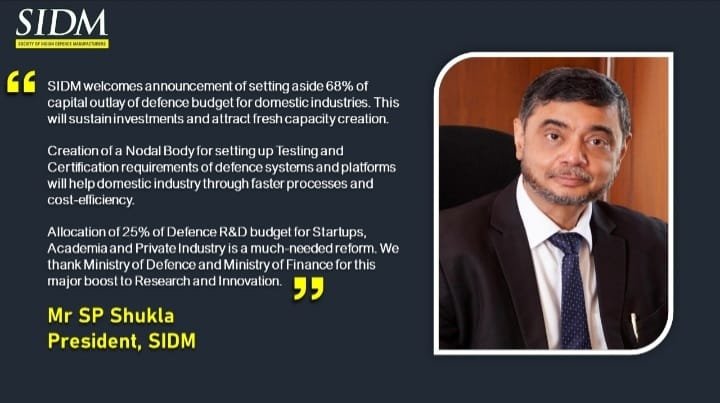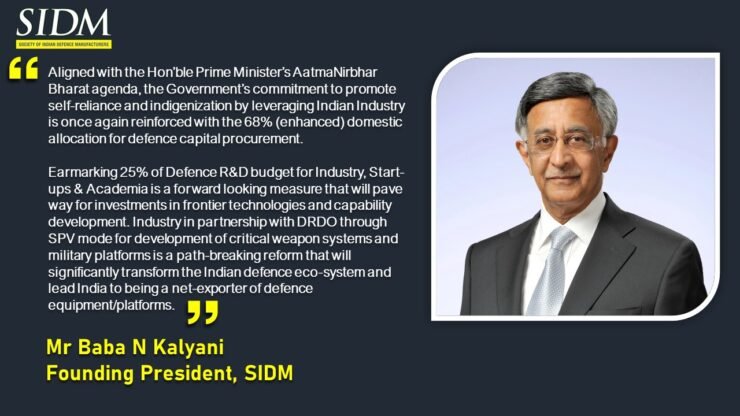
New Delhi: In keeping with the government’s commitment to Atmanirbhar or self-reliance in defence sector and boost the private sector, the Union Budget 2022-23 presented in Parliament February 1 by Finance Minister Nirmala Sitharaman has earmarked 68 per cent for capital procurement for domestic industry up from 58 per cent in 2021-22.
The budget reiterated the government’s focus on domestic defence procurement and increased participation by the private sector into military research.
She said Defence R&D will be opened up for industry, startups and academia with 25 per cent of defence R&D budget earmarked. The budget has focused on encouraging private industry to take up design and development of military platforms and equipment in collaboration with DRDO and other organizations through SPV model.
Sitharaman emphasized that an independent nodal umbrella body will be set up for meeting wide ranging testing and certification requirements.
In FY22, the Ministry of Defence’s budget’s capital outlay was Rs 1.35 trillion, a jump of almost 19 percent over FY21, with the bulk targeted at new acquisitions and military modernisation. In total, the Budgetary allocation to the Ministry of Defence has risen 9% year-on-year to Rs 5.25 trillion in FY23 from Rs 4.7 trillion in FY22.
“Our Government is committed to reducing imports and promoting Atmanirbharta in equipment for the Armed Forces. 68 per cent of the capital procurement budget will be earmarked for the domestic industry in 2022-23, up from 58 per cent in 2021-22,” the Finance Minister said.
“Artificial intelligence, geospatial systems and drones, semiconductors and its ecosystem, space economy, genomics and pharmaceuticals, green energy, and clean mobility systems have immense potential to assist sustainable development at scale and modernize the country,” she said.
“Supportive policies, light-touch regulations, facilitative actions to build domestic capacities, and promotion of research and development will guide the government’s approach. For R&D in these sunrise opportunities, in addition to efforts of collaboration among academia, industry and public institutions, government contribution will be provided,” she said.
The private sector can also now develop military platforms in collaboration with the government-owned Defence Research and Development Organisation. The defence budget consists primarily of a large capital outlay, revenue expenditure (for small acquisitions and spares) and defence pensions.

Keeping in mind the ongoing tensions along the Northern border with China along the Line of Actual Control (LAC) and in the West with Pakistan along the Line Of Control (LOC), the ministry’s capital outlay in FY22 was Rs 1.35 trillion, a jump of almost 19 percent over FY21, with the bulk targeted at new acquisitions and military modernisation. The revenue outlay had marginally increased to about Rs 2.12 trillion while the defence pensions outlay reduced year-on-year to about Rs 1.16 trillion.
Despite only a modest increase in outlay last year, the defence services had been unusually slow in spending their capital budgets this fiscal, with the army spending only about 40 percent of its allocation, while the Indian Air Force (IAF) has spent about 70 percent. The navy spent 90 percent of its capital outlay for the fiscal.
To enhance the functional autonomy and efficiency of defence-related manufacturing operations, in October 2021 the government carved out seven new defence companies out of the government department Ordnance Factory Board. These fully-owned government companies are Munitions India Ltd, Armoured Vehicles Nigam Ltd, Advanced Weapons and Equipment India Ltd, Troop Comforts Ltd, Yantra India Ltd and India Optel Ltd and Gliders India Ltd.
The Society for Indian Defence Manufacturers (SIDM) welcomed the announcement of setting aside 68% of capital outlay of defence budget for domestic industries saying it would sustain investments and attract fresh capacity creation.
SP Shukla, President – SIDM termed the budget announcement as a positive step which will help in creating jobs and investments.
He said, “Creation of a Nodal Body for setting up Testing and Certification requirements of defence systems and platforms will help domestic industry through faster processes and cost-efficiency.”
The allocation of 25% of Defence R&D budget for Startups, Academia and Private Industry is a much-needed reform and SIDM thanked Ministry of Defence and Ministry of Finance for this major boost to Research and Innovation.

Congratulating the Government, Baba N. Kalyani, CMD Bharat Forge Ltd said, “It’s a growth propelling budget with significant thrust on enhancing competitiveness, infrastructure development, holistic digital drive and promoting financial inclusion.”
Baba Kalyani said that the Government’s commitment to promote self-reliance and indigenization by leveraging Indian Industry is once again reinforced with the 68% (enhanced) domestic allocation for defence capital procurement. Earmarking 25% of Defence R&D budget for Industry, Start-ups & Academia is a forward looking measure that will pave way for investments in frontier technologies and capability development. Industry in partnership with DRDO through SPV mode for development of critical weapon systems and military platforms is a path-breaking reform that will significantly transform the Indian defence eco-system and lead India to being a net-exporter of defence equipment/platforms.
He lauded the thrust given to new-age technologies and wider adoption of digital platforms in Healthcare, Education, FinTech, Agriculture among others.








